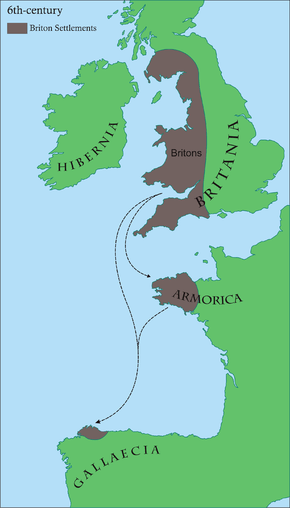Britonia
Britonia (which became Bretoña in Spanish) is the historical, apparently Latinized name of a Celtic settlement, presently Santa Maria de Bretoña, in the Province of Lugo, autonomous community of Galicia, Spain.

History
It was established in Kingdom of the Suebi, in the Roman Gallaecia, northwestern Hispania, in the late 5th and early 6th centuries AD by Romano-Britons escaping the Anglo-Saxons, who were conquering Britain. Britonia is therefore similar to Brittany in Gaul (present-day France) in that it was settled by expatriate Britons at roughly the same time.
Ecclesiastical history
What little is known of Britonia is deduced from its religious history. The British settlements were recognised at the First Council of Lugo in 569 and a separate bishopric established, on territory split off from the then Metropolitan Archdiocese of Lugo. Mailoc was nominated Bishop of Britonia and signed the acta at the Second Council of Braga in 572.
The British Celtic settlements were quickly integrated and their adherence to Celtic rite lasted only until the Fourth Council of Toledo in 633 decreed the now so-called Visigothic or Mozarabic rite as the standard liturgy of Hispania.
The diocese was suppressed in 716. The line of (errant?) bishops of Britonia nevertheless existed at least until 830, when the area was attacked by the Vikings; it may have continued as late as the Council of Oviedo in 900.
It was finally restored as or merged into the Diocese of Mondoñedo-Ferrol in 866, being assigned territories split off from the Diocese of Oviedo and from the Metropolitan Archdiocese of Lugo (since 1071 a suffragan of Santiago de Compostela).
Resident Bishops of Bretoña
Known bishops of the ecclesia Brittaniensis include :
- Mailoc (Second Council of Braga, 572 - death ?)
- Metopius (Fourth Council of Toledo, 633)
- Sonna (Seventh Council of Toledo, 646 - 653?)
- Susa (Eighth Council of Toledo, 653 - ?675)
- Bela (Third Council of Braga, 675 - ?)
Titular see
No longer a residential bishopric, Britonia is today listed by the Catholic Church as a titular see.[1]
The diocese was nominally restored in 1969 as Latin Titular bishopric of Britonia (also Curiate Italian) / Britonien(sis) (Latin adjective).
It has had the following incumbents, so far secular priests of the fitting Episcopal (lowest) rank :[2]
- Eugene O’Callaghan (1969.11.28 – resigned 1971.01.26), on emeritate as former Bishop of Clogher (Ireland) (1943.01.30 – 1969.11.28), died 1973
- John Brewer (1971.05.31 – 1985.05.22), first as Auxiliary Bishop of Diocese of Shrewsbury (England, UK) (1971.05.31 – 1983.11.17), then as Coadjutor Bishop of Lancaster (England) (1983.11.17 – 1985.05.22); later succeeded as Bishop of Lancaster (1985.05.22 – death 2000.06.10)
- Edward Joseph O’Donnell (1983.12.06 – 1994.11.08) as Auxiliary Bishop of Archdiocese of Saint Louis (USA) (1983.12.06 – 1994.11.08); later Bishop of Lafayette in Louisiana (USA) (1994.11.08 – retired 2002.11.08); died 2009
- Paweł Cieślik (1994.12.03 – ...), as former Auxiliary Bishop of Diocese of Koszalin–Kołobrzeg (Poland) (1994.12.03 – 2015.09.19) and as emeritate (1994.12.03 – ...)
References
- ↑ Annuario Pontificio 2013 (Libreria Editrice Vaticana 2013 ISBN 978-88-209-9070-1), p. 853
- ↑ http://www.gcatholic.org/dioceses/former/t0344.htm
Sources and external links
- (in English) Site dedicated to Britonia research
- GCatholic - titular see of Britonia, with Google satellite photo
- GCatholic - Diocese of Mondoñedo–Ferrol, successor see of Britonia, with Google mape and - satellite photo
- catholic-hierarchy.org - Present Latin Catholic titular see of Britonia
Sources - bibliography
- Richards, Melville, "Mailoc", Habis, III, 1972, p. 159.
- Tovar, António, "Un obispo con nombre británico y los orígenes de la diócesis de Mondoñedo", Habis, III, 1972, pp. 155–158.
- Vives, J., Concilios visigóticos e hispano-romanos, Madrid, 1963.
- Young, Simon (Summer 2003). "The Bishops of the early medieval diocese of Britonia". Cambrian Medieval Celtic Studies (45): 1–20.
- Young, Simon, "Note on Britones in Thirteenth-century Galicia", Studia Celtica, XXXV (2001), pp. 361–2.
- Young, Simon, "The Forgotten Colony", History Today, L, oct. 2000, pp. 5–6.
- Young, Simon, Britonia: Camiños Novos, Noia, 2002. ISBN 84-95622-58-0. (in Galician)